The Cardano price has formed a double-bottom pattern, indicating an eventual rebound as whales accumulate.
Cardano (ADA) rose to an intraday high of $0.715 on Wednesday, its highest level since March 28 and 40% above its lowest point this month.
The coin jumped as the stock and crypto markets recovered. Bitcoin (BTC) crossed the key resistance level at $94,000 for the first time in over a month. Similarly, the Dow Jones, Nasdaq 100, and S&P 500 indices rose by 1.5%, 2%, and 3%, respectively.
The market reacted to a statement by Donald Trump that he was not seeking to fire Jerome Powell, the chairman of the Fed. Trump and the Treasury Secretary also hinted that they were ready to have a trade deal with China.
The ongoing trade war has raised concerns that the U.S. economy could slide into a recession or stagflation. In a report on Tuesday, the IMF downgraded U.S. economic growth for 2025 from 2.4% to 1.8%, citing the impact of tariffs.
Cardano’s rally also coincided with increased accumulation by whales. According to Santiment data, Cardano holders with between 10 million and 100 million coins now account for 36% of the total supply, up from 33.4% in January.
Additional data shows that a growing number of Cardano holders are currently in profit. Over 24.5 billion ADA tokens are now in profit, up from 19.5 billion earlier this month.
Cardano price technical analysis

The ADA price has rebounded after bottoming at $0.512 on April 7. This level was significant as it coincided with the lowest swing on February 13, forming a double-bottom chart pattern, with the neckline at $1.173.
Cardano has moved slightly above the 50-day Exponential Moving Average and has also broken above the upper boundary of the falling wedge pattern, a popular bullish reversal sign.
Additionally, ADA has surpassed the 61.8% Fibonacci Retracement level, and the Relative Strength Index is pointing upward. These indicators suggest the coin will likely continue rising, with bulls targeting the $1 resistance level, about 43% above the current price.
Read the full article here
